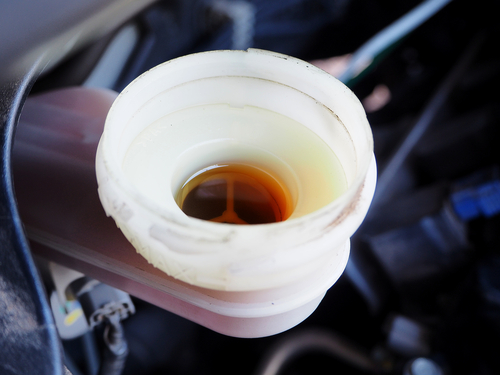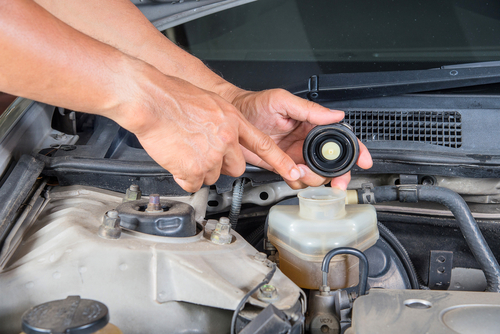A car being able to brake is much more important than it being able to drive. Therefore the brake fluid is by far the most important operational fluid in every car. If it is lacking or something is wrong with it, the safety of the car and every other traffic participant is in danger. Read everything in this article what you need to know about brake fluid.
Hydraulic force transmission and boosting
 The brake system, with the exception of the parking brake, is operated by hydraulics in family cars, meaning the braking force is transmitted through fluids. Fluids possess the property of equally dispensing within a system of tubes and recipients and cannot be compressed. The force applied by e.g. stepping on the brake pedal has an immediate effect on the entire system. The brake system, with the exception of the parking brake, is operated by hydraulics in family cars, meaning the braking force is transmitted through fluids. Fluids possess the property of equally dispensing within a system of tubes and recipients and cannot be compressed. The force applied by e.g. stepping on the brake pedal has an immediate effect on the entire system. |
 Alternatively there are pneumatic brake systems as well as hybrid systems, in which hydraulic and pneumatic components work together. These systems can be found in trucks and buses. That is the reason why these vehicles hiss when they come to a halt at the traffic light. Both systems are tuned to each other. Gases can be compressed, reducing and delaying its force transmission. This is the main difference between hydraulic and pneumatic systems. Alternatively there are pneumatic brake systems as well as hybrid systems, in which hydraulic and pneumatic components work together. These systems can be found in trucks and buses. That is the reason why these vehicles hiss when they come to a halt at the traffic light. Both systems are tuned to each other. Gases can be compressed, reducing and delaying its force transmission. This is the main difference between hydraulic and pneumatic systems. |
 Family cars are exclusively equipped with hydraulic brake systems. Only the parking brake is operated by a cable. Gases in the brake lines can have fatal consequences: they can lead to a complete failure of the brake system, causing the driver to step into a vacuum. There is nothing he can do to prevent the car from crashing into an obstacle. Family cars are exclusively equipped with hydraulic brake systems. Only the parking brake is operated by a cable. Gases in the brake lines can have fatal consequences: they can lead to a complete failure of the brake system, causing the driver to step into a vacuum. There is nothing he can do to prevent the car from crashing into an obstacle. |
How does gas enter brake fluid?
 Gas can enter brake fluid in two ways: braking can cause condense water to boil, causing steam bubbles. Furthermore, air can enter the braking system through leakages. This is rare, but can occur in older braking systems or by using the wrong brake fluid.
Gas can enter brake fluid in two ways: braking can cause condense water to boil, causing steam bubbles. Furthermore, air can enter the braking system through leakages. This is rare, but can occur in older braking systems or by using the wrong brake fluid.

Brake fluid ► now 50% cheaperfrom only £ 5,76Buy online ⇒ |
Particularly critical is water in the brake fluid. This liquid has specific properties and tasks:
|
– Resistance and reliability at high and low temperatures |
Main enemy: water
 Brake fluid available in general trade is capable of meeting these requirements, though not without side effects. One if these effects is the fluid being hygroscopic, i.e. it attracts water. Brake fluid available in general trade is capable of meeting these requirements, though not without side effects. One if these effects is the fluid being hygroscopic, i.e. it attracts water.Just like a block of salt absorbing condense water from the air, brake fluid gradually attracts water. |
 Fortunately, water accumulation is clearly visible. Fresh brake fluid is clear and golden yellow. Old and contaminated brake fluid is green and murky. Fortunately, water accumulation is clearly visible. Fresh brake fluid is clear and golden yellow. Old and contaminated brake fluid is green and murky.Beware: when brake fluid has this colour, the moment of safe change has been exceeded. Immediate action is required! |
Always changing completely
 Prior to change the brake liquid level should be checked. If it is too low, the system is obviously losing this important hydraulic liquid. The leakage must be found and repaired first, before new brake fluid is added.
Prior to change the brake liquid level should be checked. If it is too low, the system is obviously losing this important hydraulic liquid. The leakage must be found and repaired first, before new brake fluid is added.
 Take care: Simply adding new brake fluid is wrong and dangerous. The fresh brake fluid would be contaminated immediately. Furthermore the leakage is not repaired and the brake system will fail sooner or later.
Take care: Simply adding new brake fluid is wrong and dangerous. The fresh brake fluid would be contaminated immediately. Furthermore the leakage is not repaired and the brake system will fail sooner or later.
 Brake fluid is therefore always changed completely. It is either siphoned or drained at the venting screw of the wheel-brake cylinder.
Brake fluid is therefore always changed completely. It is either siphoned or drained at the venting screw of the wheel-brake cylinder.
Professional garages additionally blow the brake system with pressurised air in order to free it from all fluid residue.
Don’t forget to vent
The fresh brake fluid is not added just like that. The entire brake system must be vented so that it only contains fluid and no air.
 The easy way is placing a helper behind the steering wheel. Start with the wheel-brake cylinder which is furthest removed from the brake pedal. For right-hand steered vehicles like those on the British Isles, this is the left rear wheel. Its air-vent screw is opened. The helper pumps the brake pedal until brake fluid runs out. Now, the air-vent screw is quickly screwed tight and the procedure is repeated on all wheels. Meanwhile the fluid level must be checked.
The easy way is placing a helper behind the steering wheel. Start with the wheel-brake cylinder which is furthest removed from the brake pedal. For right-hand steered vehicles like those on the British Isles, this is the left rear wheel. Its air-vent screw is opened. The helper pumps the brake pedal until brake fluid runs out. Now, the air-vent screw is quickly screwed tight and the procedure is repeated on all wheels. Meanwhile the fluid level must be checked.
Sticking to maintenance schedules
 According to law, the brake liquid in a car must be changed every two years. This is covered by MOT inspection, and therefore old brake fluid should be identified on occasion of the inspection. The inspection, however, does not check the composition of the brake fluid, but only the function and tightness of the brake system.
According to law, the brake liquid in a car must be changed every two years. This is covered by MOT inspection, and therefore old brake fluid should be identified on occasion of the inspection. The inspection, however, does not check the composition of the brake fluid, but only the function and tightness of the brake system.
The condition of the brake liquid is therefore essential in case of purchase of a used car. It might have been stationary for a very long time or the previous owner did not mind maintenance intervals.
| Our tip: the accessory trade has testing strips for measuring water content of brake fluid. Nevertheless we recommend to change oil as well as brake fluid when purchasing a used car. |
Do not pour the old brake fluid into the sewage system, but treat it as chemical waste. It can be poured into the container of the new oil and handed in at the point of purchase. The supplier will take care of its disposal. Alternatively it can be sent to the online shop or handed in at the waste disposal facility free of charge.
Brake fluid cannot be mixed
 Brake fluid should never be topped up indiscriminately. The same brake liquid should always be used for changing or levelling out: the version prescribed by the manufacturer. The right fluid can be specified according to the DOT code on the packing.
Brake fluid should never be topped up indiscriminately. The same brake liquid should always be used for changing or levelling out: the version prescribed by the manufacturer. The right fluid can be specified according to the DOT code on the packing.
|
In Europe this is generally DOT 1 – 4. |
The wrong brake liquid can affect the components of the brake system, possibly causing leakage and pollution of the system. Both can lead to dangerous driving situation if the brake fails.
Mind the branded quality
 The brake is the most important car part. Its components should always be of first class branded quality. This also applies to brake fluid. No-name products from unknown sources could be falsifications and of inferior quality, constituting an incalculable risk. Brakes require first class material even if it costs more. The safety is worth it.
The brake is the most important car part. Its components should always be of first class branded quality. This also applies to brake fluid. No-name products from unknown sources could be falsifications and of inferior quality, constituting an incalculable risk. Brakes require first class material even if it costs more. The safety is worth it.
Foto: Fouad A. Saad, loraks, AlexLMX, sarawutnirothon, Romeo Pj, Chirachai Phitayachamrat, Dmitry Kalinovsky, EremeevStas, FabrikaSimf, Charles Knowles, g-stockstudio / shutterstock.com












